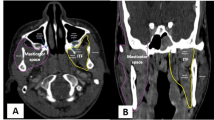Abstract
Background
Improvements in image guidance, endoscopy, and instruments, have significantly advanced “keyhole” neurosurgery. We describe the concept and technique of the supraorbital keyhole approach.
Methods
The supraorbital keyhole approach is performed through an eyebrow skin incision. Image guidance may be used to define the optimal surgical trajectory. A limited supraorbital craniotomy is fashioned. The frontal lobe is mobilized and the central skull base approached, without the need for brain retractors. Endoscopy is used to enhance visualization, and tube-shaft instruments to improve manipulation through the narrow surgical corridor.
Conclusions
The supraorbital keyhole approach provides a safe method to access selected skull base lesions.




Similar content being viewed by others
Abbreviations
- CN I:
-
Olfactory nerve
- CN II:
-
Optic nerve
- CG:
-
Crista galli
- ICA:
-
Internal carotid artery
- iCT:
-
Intraoperative computed tomography
- FB:
-
Frontal skull base
- MRI:
-
Magnetic resonance imaging
- OG:
-
Olfactory groove
References
Berhouma M, Jacquesson T, Jouanneau E (2011) The fully endoscopic supraorbital trans-eyebrow keyhole approach to the anterior and middle skull base. Acta Neurochir 153:1949–1954
Jane JA, Park TS, Pobereskin LH, Winn HR, Butler AB (1982) The supraorbital approach: technical note. Neurosurgery 11:537–542
Menovsky T, Grotenhuis JA, de Vries J, Bartels RH (1999) Endoscope-assisted supraorbital craniotomy for lesions of the interpeduncular fossa. Neurosurgery 44:106–110, discussion 110–102
Steiger HJ, Schmid-Elsaesser R, Stummer W, Uhl E (2001) Transorbital keyhole approach to anterior communicating artery aneurysms. Neurosurgery 48:347–351, discussion 351–342
van Lindert E, Perneczky A, Fries G, Pierangeli E (1998) The supraorbital keyhole approach to supratentorial aneurysms: concept and technique. Surg Neurol 49:481–489, discussion 489–490
Zador Z, Gnanalingham K (2013) Eyebrow craniotomy for anterior skull base lesions: how I do it. Acta Neurochir 155:99–106
Reisch R, Marcus HJ, Hugelshofer M, Koechlin NO, Stadie A, Kockro RA (2014) Patients’ cosmetic satisfaction, pain, and functional outcomes after supraorbital craniotomy through an eyebrow incision. J Neurosurg 121:730–734
Acknowledgments
We express our gratitude to Zsolt Kulcsár, Daniel Rüfenacht, Isabel Wanke, and Stefan Wetzel for neuroradiological and interventional support and excellent daily cooperation. Hans Rudolf Briner performed the pre- and postoperative olfaction tests, Dominik Zumsteg the intraoperative neuromonitoring, and Karen Wachter the pre- and postoperative neuropsychological evaluations in the presented illustrative case.
Conflicts of interest
None.
Author information
Authors and Affiliations
Corresponding author
Electronic supplementary material
Below is the link to the electronic supplementary material.
(MOV 53386 kb)
Rights and permissions
About this article
Cite this article
Reisch, R., Marcus, H.J., Kockro, R.A. et al. The supraorbital keyhole approach: how I do it. Acta Neurochir 157, 979–983 (2015). https://doi.org/10.1007/s00701-015-2424-6
Received:
Accepted:
Published:
Issue Date:
DOI: https://doi.org/10.1007/s00701-015-2424-6




